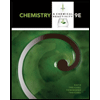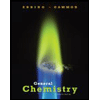
Mastering Chemistry with Pearson eText -- Standalone Access Card -- for Introductory Chemistry (6th Edition)
6th Edition
ISBN: 9780134565927
Author: Nivaldo J. Tro
Publisher: PEARSON
expand_more
expand_more
format_list_bulleted
Textbook Question
Chapter 16, Problem 86E
Make a sketch of an
Mg (s)+Ni2+ (aq)→Mg2+ (aq)+Ni (s)
Expert Solution & Answer
Want to see the full answer?
Check out a sample textbook solution
Students have asked these similar questions
Come and compare the Bronsted-Bjerrum calculation, the Debye and Hückel calculation, and the Davies calculation.
plz watch the youtube video (the title of this topic) by roxi H. she explains it step by step but i get the wrong answer
Writing the rate law implied by a simple mechanism
To exit full screen, press and hold esc
Suppose the decomposition of ozone proceeds by the following mechanism:
step
elementary reaction
rate constant
1
→>>
O3(9) O2(g) + O(g)
k₁
2
03(g) + O(g)
→
202(g)
k2
Suppose also k₁ »k2. That is, the first step is much faster than the second.
Write the balanced
chemical equation for the
overall chemical reaction:
Write the experimentally-
observable rate law for the
overall chemical reaction.
☐
rate
=
☐
Note: your answer should
not contain the
concentrations of any
intermediates.
Express the rate constant
k for the overall chemical
reaction in terms of K1, K2,
and (if necessary) the rate
constants k-1 and K-2 for
the reverse of the two
elementary reactions in
the mechanism.
k =
☐
000
18
ローロ
Ar
OO
Chapter 16 Solutions
Mastering Chemistry with Pearson eText -- Standalone Access Card -- for Introductory Chemistry (6th Edition)
Ch. 16 - Q1. Which substance is being oxidized in the...Ch. 16 - What always happens to an oxidizing agent during a...Ch. 16 - Q3. What is the oxidation state of carbon in...Ch. 16 - Q4. In which compound does phosphorus have the...Ch. 16 - Sodium reacts with water according to the...Ch. 16 - Q6. How many electrons are exchanged when this...Ch. 16 - Prob. 7SAQCh. 16 - Prob. 8SAQCh. 16 - Prob. 9SAQCh. 16 - Prob. 10SAQ
Ch. 16 - 1. What is a fuel-cell electric vehicle?
Ch. 16 - Prob. 2ECh. 16 - Prob. 3ECh. 16 - Prob. 4ECh. 16 - Prob. 5ECh. 16 - Prob. 6ECh. 16 - Prob. 7ECh. 16 - Prob. 8ECh. 16 - Prob. 9ECh. 16 - Prob. 10ECh. 16 - Prob. 11ECh. 16 - Prob. 12ECh. 16 - Prob. 13ECh. 16 - Prob. 14ECh. 16 - Prob. 15ECh. 16 - Prob. 16ECh. 16 - Prob. 17ECh. 16 - Prob. 18ECh. 16 - Prob. 19ECh. 16 - 20. Any half-reaction in the activity series will...Ch. 16 - How can you use the activity series to determine...Ch. 16 - What is electrical current? Explain how a simple...Ch. 16 - Prob. 23ECh. 16 - Prob. 24ECh. 16 - Prob. 25ECh. 16 - Prob. 26ECh. 16 - Prob. 27ECh. 16 - Prob. 28ECh. 16 - Prob. 29ECh. 16 - Prob. 30ECh. 16 - Prob. 31ECh. 16 - Prob. 32ECh. 16 - Prob. 33ECh. 16 - Prob. 34ECh. 16 - Prob. 35ECh. 16 - Prob. 36ECh. 16 - Prob. 37ECh. 16 - 38. For each of the reactions in Problem 36,...Ch. 16 - Prob. 39ECh. 16 - Prob. 40ECh. 16 - Prob. 41ECh. 16 - Prob. 42ECh. 16 - Prob. 43ECh. 16 - Prob. 44ECh. 16 - 45. Assign an oxidation state to each element or...Ch. 16 - Prob. 46ECh. 16 - 47. Assign an oxidation state to each atom in each...Ch. 16 - Prob. 48ECh. 16 - Prob. 49ECh. 16 - Prob. 50ECh. 16 - Prob. 51ECh. 16 - Prob. 52ECh. 16 - Prob. 53ECh. 16 - Prob. 54ECh. 16 - Prob. 55ECh. 16 - Prob. 56ECh. 16 - Prob. 57ECh. 16 - Assign an oxidation state to each element in each...Ch. 16 - 59. Use oxidation states to identify the oxidizing...Ch. 16 - Prob. 60ECh. 16 - 61. Balance each redox reaction using the...Ch. 16 - Prob. 62ECh. 16 - Classify each half-reaction occurring in acidic...Ch. 16 - 64. Classify each half-reaction occurring in...Ch. 16 - Use the half-reaction method to balance each redox...Ch. 16 - Use the half-reaction method to balance each redox...Ch. 16 - Prob. 67ECh. 16 - Prob. 68ECh. 16 - Balance each redox reaction occurring in basic...Ch. 16 - Prob. 70ECh. 16 - Prob. 71ECh. 16 - Prob. 72ECh. 16 - Prob. 73ECh. 16 - Prob. 74ECh. 16 - Prob. 75ECh. 16 - Prob. 76ECh. 16 - 77. Determine whether each redox occurs...Ch. 16 - Prob. 78ECh. 16 - 79. Suppose you wanted to cause ions to come out...Ch. 16 - Prob. 80ECh. 16 - Prob. 81ECh. 16 - 82. Which metal in the activity series is oxidized...Ch. 16 - Prob. 83ECh. 16 - Prob. 84ECh. 16 - Prob. 85ECh. 16 - 86. Make a sketch of an electrochemical cell with...Ch. 16 - Prob. 87ECh. 16 - The following reaction occurs at the cathode of an...Ch. 16 - Prob. 89ECh. 16 - Prob. 90ECh. 16 - Prob. 91ECh. 16 - Make a sketch of an electrolysis cell that could...Ch. 16 - Prob. 93ECh. 16 - Prob. 94ECh. 16 - 95. Determine whether each reaction is a redox...Ch. 16 - Prob. 96ECh. 16 - Consider the unbalanced redox reaction....Ch. 16 - Prob. 98ECh. 16 - Prob. 99ECh. 16 - Prob. 100ECh. 16 - Prob. 101ECh. 16 - 102. A 1.012-mL sample of a salt containing is...Ch. 16 - Prob. 103ECh. 16 - Prob. 104ECh. 16 - Determine whether HI can dissolve each metal...Ch. 16 - 106. Determine whether HI can dissolve each metal...Ch. 16 - Prob. 107ECh. 16 - 108. One graduated cylinder containing 1.00 mL of...Ch. 16 - Prob. 109ECh. 16 - Prob. 110ECh. 16 - Prob. 111ECh. 16 - Prob. 112ECh. 16 - 113. Consider the molecular view of an...Ch. 16 - Which of your group’s cells do you think would...Ch. 16 - Data Interpretation and Analysis
116. We can use...
Knowledge Booster
Learn more about
Need a deep-dive on the concept behind this application? Look no further. Learn more about this topic, chemistry and related others by exploring similar questions and additional content below.Similar questions
- Deducing a rate law from the change in concentration over time To exit full screen, press and hold esc A chemistry graduate student is studying the rate of this reaction: H2CO3(aq) → H₂O(aq) +CO₂ (aq) - She fills a reaction vessel with H2CO3 and measures its concentration as the reaction proceeds: time (milliseconds) [H2CO3] 0 0.0500 M 10. 0.0266M 20. 0.0181 M 30. 0.0138M 40. 0.0111 M Use this data to answer the following questions. Write the rate law for this reaction. Calculate the value of the rate constant k. Round your answer to 2 significant digits. Also be sure your answer has the correct unit symbol. rate ☐ x10 k = Х 000 18 Ararrow_forwardWriting the rate law implied by a simple mechanism Suppose the formation of tert-butanol proceeds by the following mechanism: step elementary reaction 1 (CH3)3 CBr(aq) → (CH3)2 C* (aq) + Br (aq) 2 (CH3)2C (aq) + OH¯ (aq) → (CH3)2COH(aq) rate constant k₁ k₂ Suppose also k₁ »k2. That is, the first step is much faster than the second. Write the balanced chemical equation for the overall chemical reaction: Write the experimentally- observable rate law for the overall chemical reaction. Note: your answer should not contain the concentrations of any intermediates. rate = k ☐ Express the rate constant k for the overall chemical reaction in terms of K1, K2, and (if necessary) the rate constants k-1 and K-2 for the reverse of the two elementary reactions in the mechanism. k = ☐ □ ☑ G ? 00. 18 Ar Barrow_forwardDeducing a rate law from the change in concentration over time A chemistry graduate student is studying the rate of this reaction: 2SO3 (g) →>> 2SO2 (g) + O2(g) He fills a reaction vessel with SO3 and measures its concentration as the reaction proceeds: ? time (minutes) [SO3] 0 0.0200M 1.0 0.0105 M 2.0 0.00552M 3.0 0.00290M 4.0 0.00152M Use this data to answer the following questions. Write the rate law for this reaction. rate = k ☐ x10 Calculate the value of the rate constant k. Round your answer to 2 significant digits. Also be sure your answer has the correct unit symbol. k = ☐ Х 000 18 Ar BAarrow_forward
- Using the Arrhenius equation to calculate k at one temperature from k at... The rate constant of a certain reaction is known to obey the Arrhenius equation, and to have an activation energy E reaction is 1.2 × 107 M −1 .S at 160.0 °C, what will the rate constant be at 194.0 °C? Round your answer to 2 significant digits. k = Шм −1 -1 .S ☐ x10 ☑ 5 = = 16.0 kJ/mol. If the rate constant of this a ? olo Ar Barrow_forwardUsing the Arrhenius equation to calculate k at one temperature from k at... a The rate constant of a certain reaction is known to obey the Arrhenius equation, and to have an activation energy E = 10.0 kJ/mol. If the rate constant of this reaction is 9.9 × 107 M -1 .S at 246.0 °C, what will the rate constant be at 196.0 °C? Round your answer to 2 significant digits. k = ☐ M -1 −1 .S x10 ☑ ? 00. 18 Ar Barrow_forwardWriting the rate law implied by a simple mechanism Suppose the reaction between nitric oxide and bromine proceeds by the following mechanism: elementary reaction - NO(g) + Br2(g) → NOBг2(g) step 1 2 NOBг2(g) + NO(g) - rate constant k₁ 2 NOBr(g) k2 Suppose also k₁ »k2. That is, the first step is much faster than the second. Write the balanced chemical equation for the overall chemical reaction: Write the experimentally- observable rate law for the overall chemical reaction. Note: your answer should not contain the concentrations of any intermediates. ☐ rate = k Express the rate constant k for the overall chemical reaction in terms of k₁, k2, and (if necessary) the rate constants k-1 and K-2 for the reverse of the two elementary reactions in the mechanism. = ☐ ロ→ロ Х ك ? 000 18 Ararrow_forward
- Deducing a rate law from the change in concentration over time chemistry graduate student is studying the rate of this reaction: 2H3PO4 (aq) → P₂O5 (aq) +3H₂O (aq) 2 e fills a reaction vessel with H3PO and measures its concentration as the reaction proceeds: 4 time (seconds) [H3PO4] 0 0.500M 1.0 0.229 M 2.0 0.148M 3.0 0.110M 4.0 0.0871 M se this data to answer the following questions. Write the rate law for this reaction. rate = k x10 Calculate the value of the rate constant k. k = Round your answer to 2 significant digits. Also be sure your answer has the correct unit symbol. ☑ G olo 18 Ararrow_forwardWriting the rate law implied by a simple mechanism Suppose the formation of nitrosyl chloride proceeds by the following mechanism: elementary reaction step rate constant 1 NO(g) + Cl2(g) → NOC₁₂(g) k₁ 2 NOCl2(g) + NO(g) 2 NOCl(g) →>> k2 Suppose also k₁ »k. That is, the first step is much faster than the second. Write the balanced chemical equation for the overall chemical reaction: Write the experimentally- observable rate law for the overall chemical reaction. rate = k ☐ Note: your answer should not contain the concentrations of any intermediates. Express the rate constant k for the overall chemical reaction in terms of K1, K2, and (if necessary) the rate constants k-1 and K-2 for the reverse of the two elementary reactions in the mechanism. k = | Х ? 18 Ararrow_forwardUsing first- and second-order integrated rate laws 1/5 Consider this reaction: H2CO3(aq) → H₂O (aq) +CO₂ (aq) At a certain temperature it obeys this rate law. rate = (2.27 s¹) [H2CO3] Suppose a vessel contains H2CO3 at a concentration of 0.830M. Calculate how long it takes for the concentration of H2CO3 to decrease by 83.0%. You may assume no other reaction is important. Round your answer to 2 significant digits. S x10 ☑ § ? 00. 18 Ararrow_forward
- Using the Arrhenius equation to calculate k at one temperature from k at... Try Again Your answer is incorrect. 0/5 a The rate constant of a certain reaction is known to obey the Arrhenius equation, and to have an activation energy E = 28.0 kJ/mol. If the rate constant of this -1 -1 reaction is 2.5 × 10³ M ·S at 45.0 °C, what will the rate constant be at 104.0 °C? Round your answer to 2 significant digits. ST -1 -1 ☐ x10 k = 2.8 × 10 - M .S 18 Ararrow_forwardIn the theory of the state of transition, indicate the expression of the constant k in function of deltaE0#. This expression is also the ecuation of Arrhenius?arrow_forwardBriefly indicate the differences between Ea of the theory of collisions and E0# the theory of the state of transition.arrow_forward
arrow_back_ios
SEE MORE QUESTIONS
arrow_forward_ios
Recommended textbooks for you
 ChemistryChemistryISBN:9781305957404Author:Steven S. Zumdahl, Susan A. Zumdahl, Donald J. DeCostePublisher:Cengage Learning
ChemistryChemistryISBN:9781305957404Author:Steven S. Zumdahl, Susan A. Zumdahl, Donald J. DeCostePublisher:Cengage Learning Chemistry: An Atoms First ApproachChemistryISBN:9781305079243Author:Steven S. Zumdahl, Susan A. ZumdahlPublisher:Cengage Learning
Chemistry: An Atoms First ApproachChemistryISBN:9781305079243Author:Steven S. Zumdahl, Susan A. ZumdahlPublisher:Cengage Learning
 Chemistry & Chemical ReactivityChemistryISBN:9781337399074Author:John C. Kotz, Paul M. Treichel, John Townsend, David TreichelPublisher:Cengage Learning
Chemistry & Chemical ReactivityChemistryISBN:9781337399074Author:John C. Kotz, Paul M. Treichel, John Townsend, David TreichelPublisher:Cengage Learning Chemistry & Chemical ReactivityChemistryISBN:9781133949640Author:John C. Kotz, Paul M. Treichel, John Townsend, David TreichelPublisher:Cengage Learning
Chemistry & Chemical ReactivityChemistryISBN:9781133949640Author:John C. Kotz, Paul M. Treichel, John Townsend, David TreichelPublisher:Cengage Learning General Chemistry - Standalone book (MindTap Cour...ChemistryISBN:9781305580343Author:Steven D. Gammon, Ebbing, Darrell Ebbing, Steven D., Darrell; Gammon, Darrell Ebbing; Steven D. Gammon, Darrell D.; Gammon, Ebbing; Steven D. Gammon; DarrellPublisher:Cengage Learning
General Chemistry - Standalone book (MindTap Cour...ChemistryISBN:9781305580343Author:Steven D. Gammon, Ebbing, Darrell Ebbing, Steven D., Darrell; Gammon, Darrell Ebbing; Steven D. Gammon, Darrell D.; Gammon, Ebbing; Steven D. Gammon; DarrellPublisher:Cengage Learning

Chemistry
Chemistry
ISBN:9781305957404
Author:Steven S. Zumdahl, Susan A. Zumdahl, Donald J. DeCoste
Publisher:Cengage Learning

Chemistry: An Atoms First Approach
Chemistry
ISBN:9781305079243
Author:Steven S. Zumdahl, Susan A. Zumdahl
Publisher:Cengage Learning


Chemistry & Chemical Reactivity
Chemistry
ISBN:9781337399074
Author:John C. Kotz, Paul M. Treichel, John Townsend, David Treichel
Publisher:Cengage Learning

Chemistry & Chemical Reactivity
Chemistry
ISBN:9781133949640
Author:John C. Kotz, Paul M. Treichel, John Townsend, David Treichel
Publisher:Cengage Learning

General Chemistry - Standalone book (MindTap Cour...
Chemistry
ISBN:9781305580343
Author:Steven D. Gammon, Ebbing, Darrell Ebbing, Steven D., Darrell; Gammon, Darrell Ebbing; Steven D. Gammon, Darrell D.; Gammon, Ebbing; Steven D. Gammon; Darrell
Publisher:Cengage Learning
Introduction to Electrochemistry; Author: Tyler DeWitt;https://www.youtube.com/watch?v=teTkvUtW4SA;License: Standard YouTube License, CC-BY